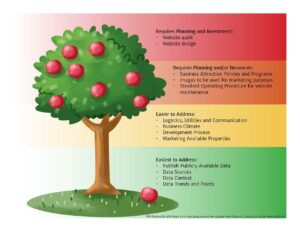Throughout modern history, the founding and continuation of communities has been predicated on compelling economic opportunities that drive individual investment of time, money, and labor to convert natural resources into monetary gain. Whether a community is founded for its access to trade routes via lakes and rivers or abundance of wildlife, timber or gold (to name a few), the founding of America has been a fascinating economic story.
Contemporary rural communities have experienced both the benefits and the downfalls of the economic case for existence. They often act as “canaries in the coal mines” for phenomena such as brain drain, industrial flight, tax base erosion and wage stagnation. Increasingly, rural communities find themselves wrapped up in what can be a life and death struggle for their downtown, historic buildings, and in some cases, their very existence.
The good news is that many of the best practices in economic development for larger communities apply to rural areas as well – and can often be performed in a much more effective manner. The bad news is that it takes dedication, budget, and expertise to leverage these efforts into incremental gains. Like football, rural economic development is a game of inches, and is most effectively accomplished when a head coach is collaborating with offensive and defensive coordinators to get the job done. While it is true that training camp doesn’t start until July, success requires teams to make football a year-round endeavor.
Great Leadership Builds Great Communities.
Winning teams credit the leadership of the organizations that they are involved in with the win. Yes, there are talented coaches, coordinators and players that are critical to that success — but it takes the collaborative efforts of an organization – not ego – to earn Superbowl titles. Therefore, first step in developing a winning rural economic development strategy is convening an organizational framework that will outlast elected tenure, individual talent, and that can assemble a legitimate team of players poised to get the job done.
Head Coach and the Big Picture.
Local officials must embrace their role as head coach. Not only do they provide an operational framework for their offensive and defensive coordinators, but they must create the culture and environment that will facilitate success for their team. This means that they must be willing to first invest in community spaces, infrastructure, and critical cultural assets to ensure that the team can be successful. It is imperative to note that head coaches expend considerable time and energy mapping out the targets and goals, outlining the investments required to reach those goals — and, critically: making investments before asking others to do so. Local officials must be prepared to put the first dimes in the bucket – especially in rural communities.
Have a Strong Offense.
For in economic development, the offense includes every form of communication about the market and within the market about that market. Think consistency and promotion of the community when branding, programming events — even in supporting local employer job fairs. Communication and programming is hypercritical in 21st Century economic development. A successful communications campaign requires three things: consistency, clarity, and value. No communications campaign can be effective without the head coach laying the ground work with investments in quality public spaces, infrastructure, and environment. Without these assets, what exactly is being touted as communication-worthy?
A Great Defense will Win the Game.
Defense for rural communities comes in two forms: engagement / collaboration, and community investment. To the extent to which the local officials are able to engage on these two fronts will be a solid indicator of its success. The strength of rural Business Retention and Expansion programs – coupled with the strength of local collaborations between schools and business will define not only future job opportunities from the student perspective, but also labor force development and future assets from the employers perspective. The third leg of that stool is the capacity for the community to create a compelling reason for the labor pool to call that area home. From community and cultural assets to opportunities to engage and contribute — the labor force the community needs and employers want, care about what has been invested in by the local leadership to ensure they have a quality of life to be proud of — which translates into big wins for the organization, head coach, coordinators, and community.
What is Right and Wrong in the state of Florida
(Richard Florida, that is.)
Richard Florida is at it again. He was an agent of community development disruption with his oft-cited 2002 book “The Rise of the Creative Class.” Recently, however, Florida has taken a look back over the past 15 years and witnessed a great deal of development that appeared to go hand-in-hand with economic carnage. In his new book, “The New Urban Crisis,” he calls out the deep economic divisions that have arisen across the nation, seemingly causing social tensions and political rifts. Not surprisingly, this gut-check on Florida’s part has become a matter of some buzz in Economic Development circles.
It appears that, despite decades of study on the subject, the nation is experiencing a metastasized version of gentrification – one that moves well beyond property values and ingrains itself deeply into the social and economic constructs of everyday lives. The “Haves” and “have-nots” are taking turns in displacing each other; the economically disadvantaged (who can little afford to get sick) have a lack of access or capacity to quality nutrition; funding cuts to education are increasingly affecting students that are economically vulnerable or disabled; and the jobs market is shifting in ways that is pushing many into poverty who would have formerly occupied the middle class.
It is imperative to first recognize that these are illustrations of the dark side of a largely virtuous free market system, and that the economic genie of the last 20 years cannot be put back in the bottle. As they say: channel your energy not in fighting for the old, but in building the new.” In this case, it can be applied to mean that community leaders, including economic development professionals should engage in initiatives and efforts that recognize and address these issues while continuing to build new, market-actuated assets for continued investment.
Gentrification, White Flight, and the power of “They”
You won’t have to search long to find an abundance of texts, narratives and studies that tout the wonders of an economic and socially-integrated society. Diversifying the peer groups within neighborhoods – has shown to enhance individual academic performance for youth formerly exposed to primarily uniformly impoverished neighborhoods. In theory, this enhanced performance increases the chance that the youth studied will have the opportunity to engage in higher learning/training and become an economic asset to society. Similarly, by ensuring that neighborhoods have a mix of housing availability – both high quality market housing and high quality affordable housing – overall property values can be kept in check, enhancing affordability for all; enabling low-income individuals access to the amenities that tend to follow high-income folks such as access to grocery stores, clinics, and quality public spaces that the affluent so often are able to lobby for.
All of these things work in theory, but the application becomes much more messy. Rather than seamlessly integrating, players of various economic strata tend to self-select groups of choice. Combating these forces rely on collaboration and connection – from education of mixed-income program policies and goals, to opportunities to make investments in their neighborhood in a manner of their choice – community members respond well to a sense of empowerment over imposition.
Building the New
Community leaders are encumbered by the responsibility to provide leadership and decision making that embraces the needs and concerns of all citizens – no matter their capacity to engage in civic conversation. Looking for ways to turn gentrification on its ear into pathways to prosperity, may be a better way to go about channeling social angst away from fighting for the old, and into building the new.
Consider programs that earmark a percentage of new property tax dollars within a district into the operation or development of training or job centers; entrepreneurship training and mentoring programs; progressive fee child care centers; ride sharing programs; community gardens; or enhanced incentives for Affordable Housing units (development, and/or operation).
While no formula will be perfect, one thing is perfectly clear: continuing on the current path is not providing the systemic mechanism required to rise the tide sufficiently to raise all boats — and when that happens, communities suffer: loss of productive workforce, loss of property tax values, and loss of disposable incomes that support local and regional retail interests.






